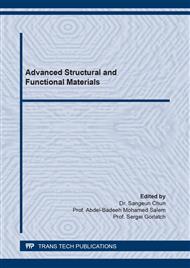p.3
p.9
p.17
p.23
p.35
p.43
p.51
p.61
Effect of Reduction Rate on the Recrystallization Behavior in AA3003 Aluminum Alloy Fabricated by DC Casting
Abstract:
The recrystallization behavior of the cold-rolled AA3003 aluminum alloy with the reduction rate of 20%, 50% and 90% during annealing at the temperature ranging from 300°C to 400°C was investigated. As increasing reduction rate, the cold rolled specimens exhibit deformation bands with elongated grain microstructure consisting of straight grain boundary parallel to rolling direction. Therefore, large density of nucleation sites for recrystallization would be expected with increase of strain energy. The grain size of the cold-rolled specimens decreased with increase of reduction rate, c.f., as the rolling reduction increased to 90%, grain size along the direction normal to the sheet decreased to about 8μm in thick. When the sample annealed at 350°C for 5s, the first recrystallized grains were observed in the vicinity of the grain boundary. The relaxation and recrystallization kinetics under different annealing conditions were characterized in terms of the Johnson–Mehl–Avrami–Kolmogorov (JMAK) model. The apparent activation energies of recrystallization for the cold-rolled specimens with reduction rate of 20%, 50% and 90% were determined as 332 kJ/mol, 239 kJ/mol and 115 kJ/mol, respectively. XRD analysis by using modified Williamson–Hall plots revealed that the tendency of the change in dislocation density is varied depending on reduction rate. These results indicate that the apparent activation energy for recrystallization and the crystallites size decrease with increase of the reduction rate, which leads to a decrease in the size of the recrystallized grains.
Info:
Periodical:
Pages:
17-22
Citation:
Online since:
June 2021
Authors:
Price:
Сopyright:
© 2021 Trans Tech Publications Ltd. All Rights Reserved
Share:
Citation:


